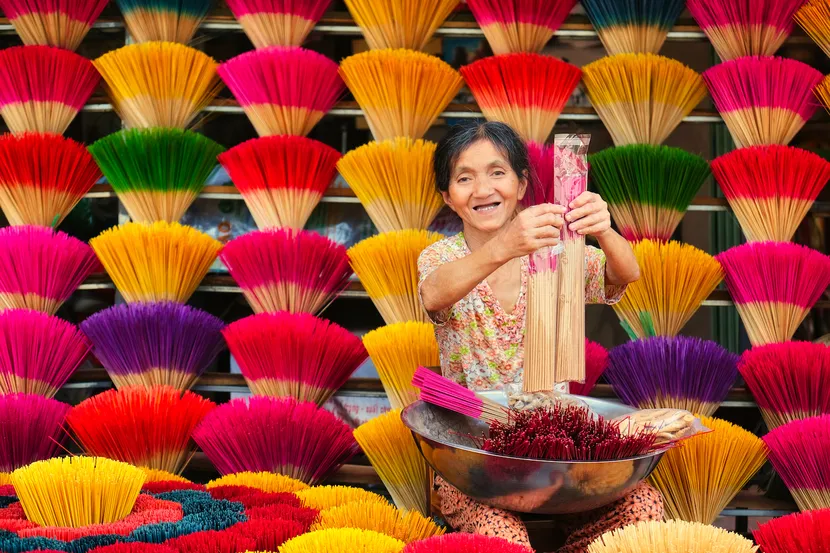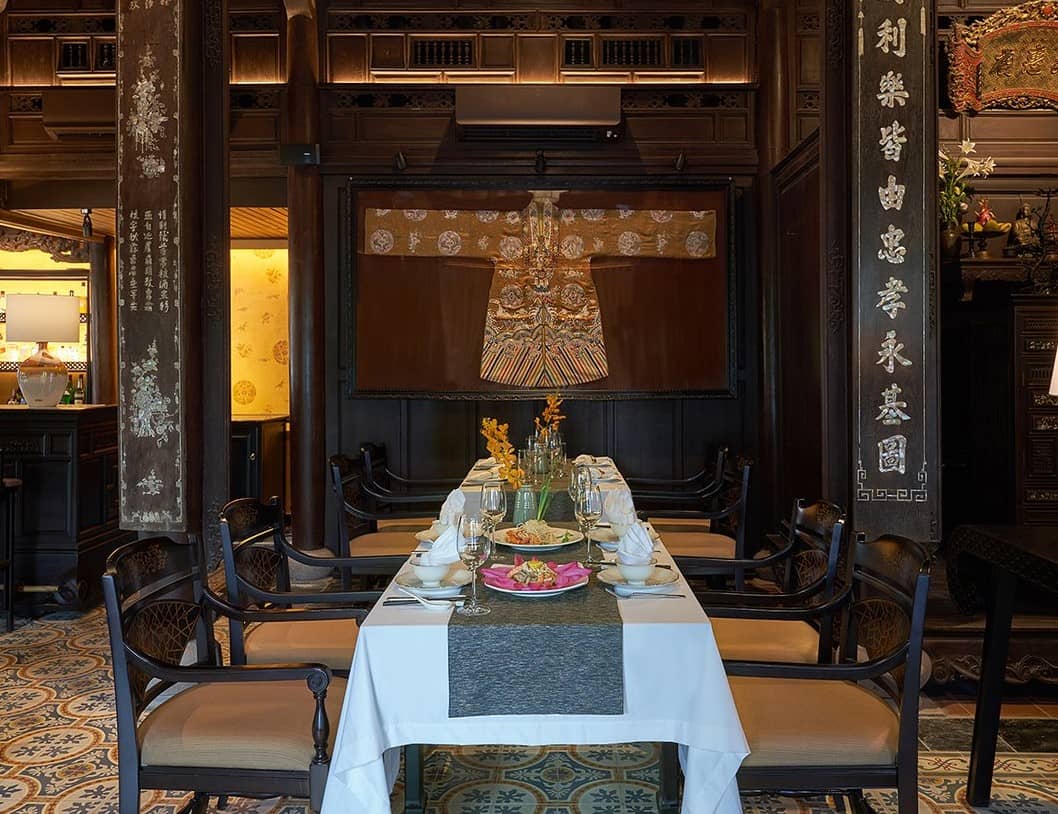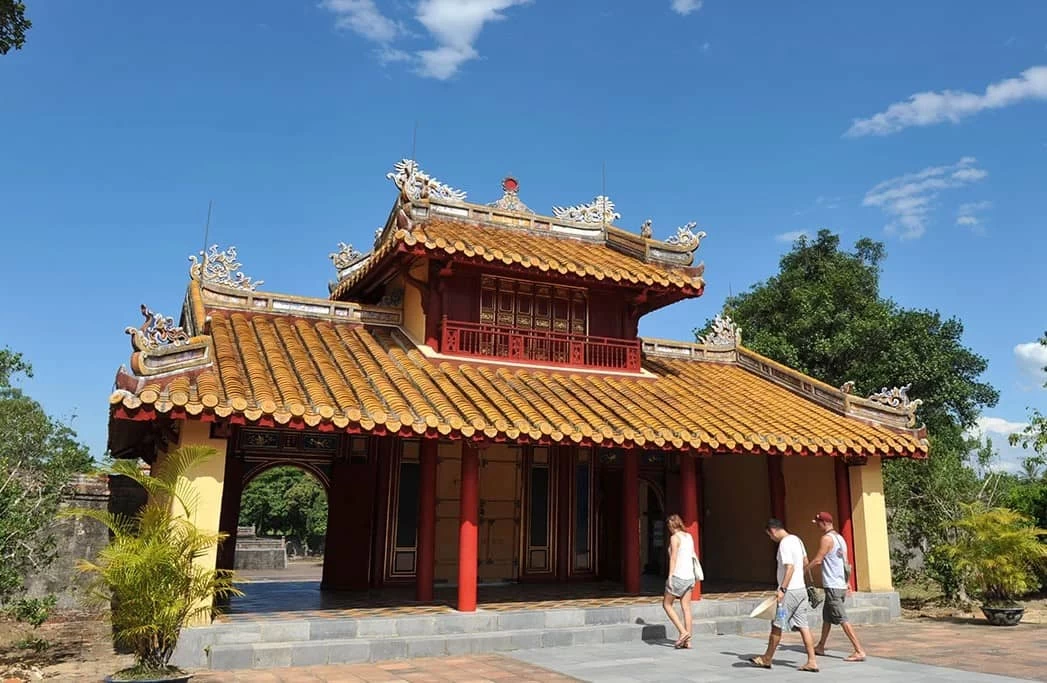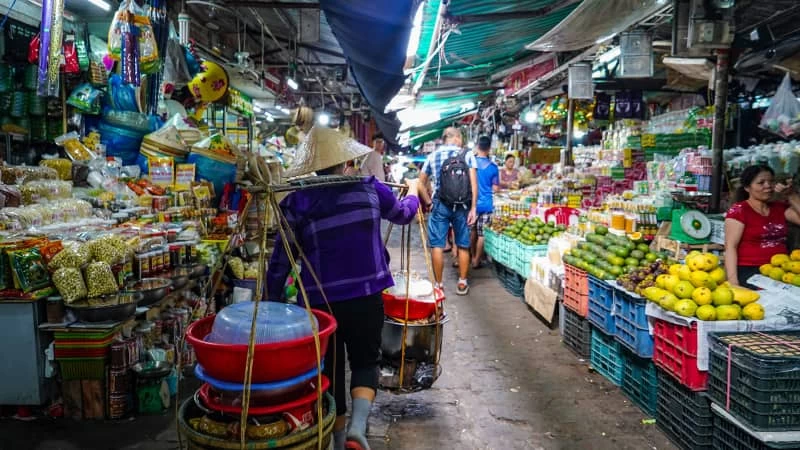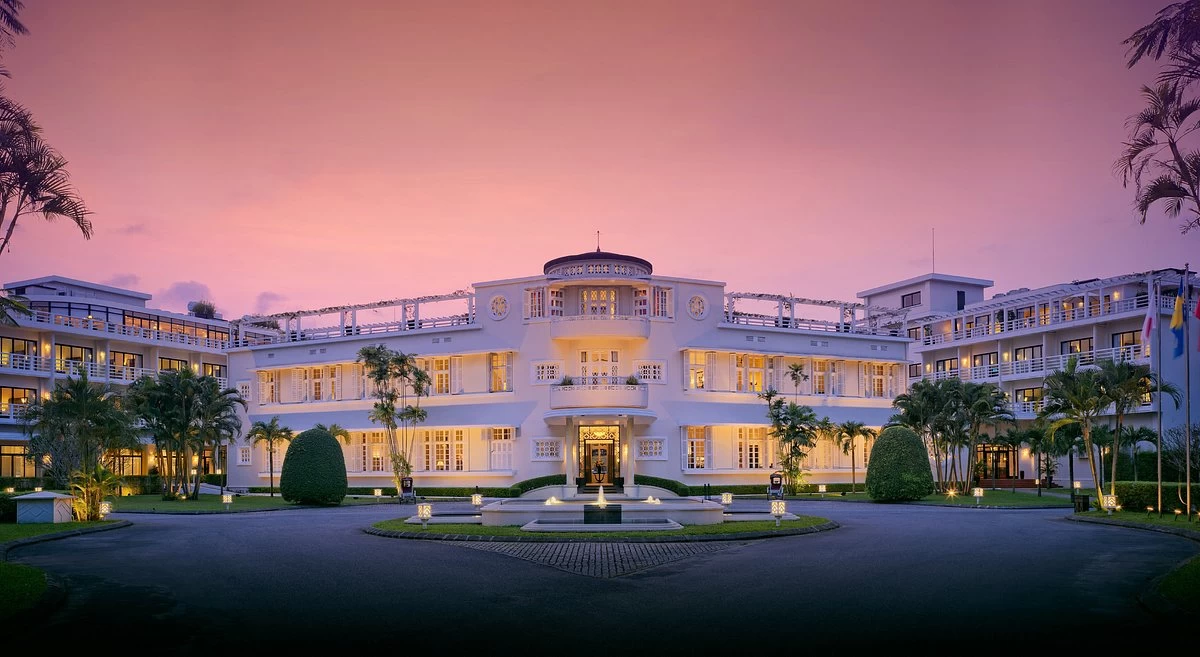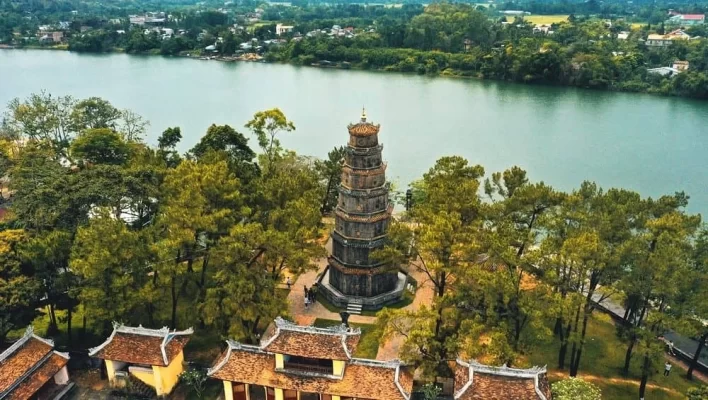
Thien Mu Pagoda on the poetic Perfume River.
Discover the timeless beauty of Thien Mu Pagoda, an iconic 17th-century temple in Hue, Vietnam. Overlooking the peaceful Perfume River, this historic site offers a blend of rich cultural heritage, stunning architecture, and serene landscapes, making it a must-visit for travelers seeking history, spirituality, and breathtaking views. Don’t miss the trip to Thien Mu Pagoda with Ula Travel!
I. Introduction to Thien Mu Pagoda
1. Overview of Thien Mu Pagoda
Thien Mu Pagoda stands as a symbol of both spiritual and historical significance in Hue, Vietnam. This centuries-old temple, with its iconic seven-story Phuoc Duyen Tower, is one of the country’s most revered Buddhist sites and an architectural gem that has captured the hearts of travelers worldwide. As the oldest pagoda in Hue, founded in 1601, Thien Mu holds deep cultural importance, reflecting the spiritual heritage of the Nguyen Dynasty and Vietnam’s enduring connection to Buddhism.
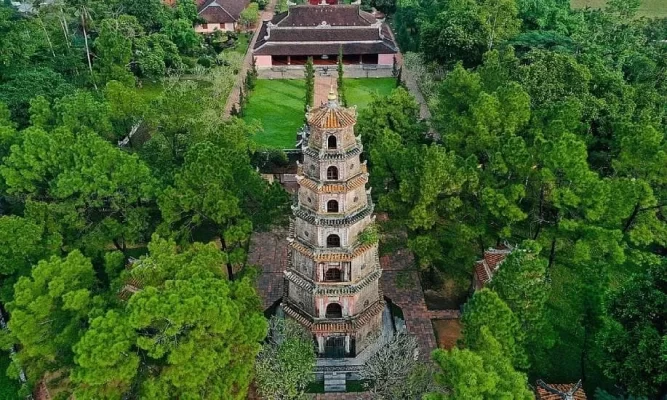
The Pagoda is a symbol of the development of Buddhism in Hue.
For international visitors, Thien Mu Pagoda offers more than just a peaceful retreat—its rich history intertwines with Vietnam’s past, making it a must-see destination. Whether you’re drawn by the temple’s religious significance, its historical role in shaping Hue’s cultural landscape, or simply its breathtaking view of the Perfume River, this sacred site provides a unique glimpse into the heart of Vietnam’s spiritual and cultural identity.
2. Where is Thien Mu Pagoda?
Thien Mu Pagoda is located on Ha Khe Hill, Nguyen Phuc Nguyen Street, Kim Long Ward, Hue City. Situated right on the northern bank of the picturesque Perfume River, the pagoda is about 5 kilometers west of Hue’s city center. This prime location not only offers convenience for visitors but also provides the pagoda with a charming natural setting, featuring the winding river below and gently rolling hills surrounding it.
II. History of Thien Mu Pagoda
Thien Mu Pagoda has a rich history closely tied to the development of the Nguyen Dynasty and Buddhism in Vietnam. Originating in the 17th century, the pagoda was built during the reign of Lord Nguyen Hoang in 1601. During an inspection tour of the Hue area, Nguyen Hoang, the first Nguyen lord of the southern region, traveled along the banks of the Perfume River and stopped at a small hill near the river.
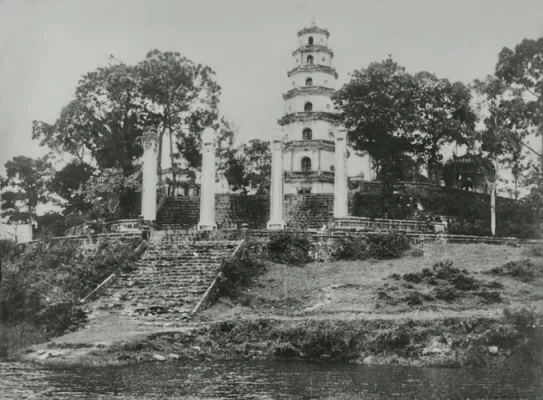
Image of Thien Mu Pagoda in the past.
Legend has it that he heard stories from locals about an old woman in a red robe who appeared on the hill, prophesying that a great leader would build a large pagoda there to bring prosperity to the land. Inspired by this tale, Nguyen Hoang decided to build Thien Mu Pagoda at this location, with deep religious and political significance.
Initially, the pagoda was a small, simple structure. However, over time, and through various dynasties, the pagoda was renovated and expanded, becoming one of the most important religious sites under the Nguyen Dynasty.
Notably, in the 19th century, under the reign of Emperor Thieu Tri, the pagoda underwent major restoration, with the addition of the Phuoc Duyen Tower—now a symbol of the pagoda. This tower stands 21 meters tall and has seven stories, each representing one of the reincarnations of Buddha. Phuoc Duyen Tower is not only an architectural marvel but also a symbol of the strong connection between Buddhism and the enduring power of the Nguyen Dynasty.
III. The Unique Architecture of Thien Mu Pagoda
1. Phuoc Duyen Tower
Phuoc Duyen Tower is the most prominent and iconic symbol of Thien Mu Pagoda. Built in 1844 during the reign of Emperor Thieu Tri, the tower features a unique octagonal design and stands 21 meters tall, consisting of seven floors, each dedicated to a statue of Buddha.
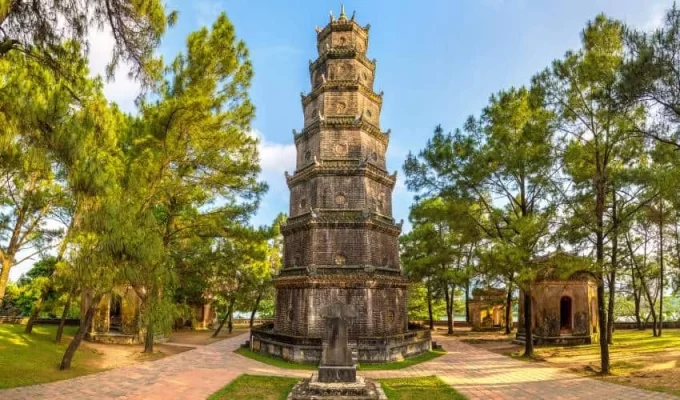
Phuoc Duyen Tower
Made from red brick, the tower stands out against the lush green surroundings of the pagoda and the meandering Perfume River nearby. Positioned centrally and visible from afar, it embodies a powerful yet graceful beauty, symbolizing the spiritual and moral ascent of humankind.
Each floor of the tower represents different stages in the life of Buddha, creating a delicate connection between religion and architecture. The intricate carvings on the tower reflect the craftsmanship of ancient artisans. From the top of Phuoc Duyen Tower, visitors can enjoy sweeping views of the poetic Perfume River and the distant city of Hue, blending nature with architecture.
Start your journey with: Da Nang to Hue – Unexpected Trip You’ll Love
2. Dai Hong Chung (The Great Bell)
The Dai Hong Chung bell is one of the most treasured artifacts of the pagoda, standing 2.5 meters tall with a circumference of 3.6 meters. Cast in 1710 during the reign of Nguyen Phuc Chu, the bell weighs over 2 tons.
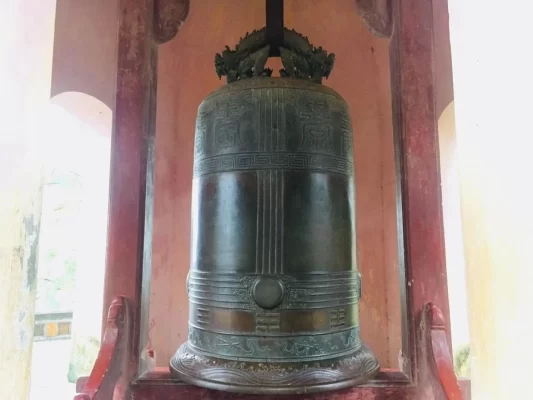
The ancient bell at Thien Mu Pagoda is named Dai Hong Chung.
Each time it is rung, its resonating sound echoes across the mountains and river, creating the serene atmosphere unique to Thien Mu Pagoda. The bell is adorned with religious motifs and carvings, symbolizing reverence and devotion to Buddhist teachings. It is not only a piece of great artistic value but also a symbol of spiritual strength.
You will be like: Central Vietnam Wonders Tour
3. Dai Hung Palace
Dai Hung Palace is the main hall of Thien Mu Pagoda, dedicated to Buddha and serving as the center of religious activities. The palace features traditional architecture with curved tiled roofs, columns adorned with dragon and cloud motifs, representing the majesty and noble spirit of Buddhism.
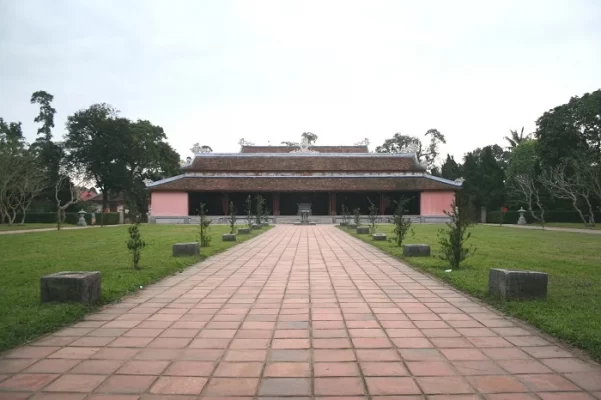
Dai Hung Palace
Inside, large Buddha statues are respectfully arranged, with a central statue of Shakyamuni Buddha. Surrounding the shrine are guardian statues and intricately carved details, each symbolizing profound Buddhist philosophy. The interior of Dai Hung Palace is solemnly decorated, with natural light filtering through finely carved wooden windows, combined with the gentle scent of incense, creating a peaceful and sacred atmosphere.
IV. How to Get to Thien Mu Pagoda
1. Taxi or Grab
This is the fastest and most convenient option for international tourists traveling from Hue’s city center to the pagoda. The journey takes about 10-15 minutes, depending on traffic. Taxi fares in Hue are quite reasonable, and Grab is also a popular choice, allowing you to easily book a ride through a mobile app.
- Benefits: Safe, convenient, and suitable for small groups or families. Local drivers often know the history of the pagoda and may share useful information.
2. Motorbike or Bicycle
For travelers who enjoy exploring and want the freedom to stop along the way for photos or sightseeing, renting a motorbike or bicycle is an ideal option. From Hue’s center, you can follow Kim Long Street along the Perfume River. This tree-lined road leads to the pagoda, taking around 20 minutes by motorbike or 30-40 minutes by bicycle.
- Benefits: You can experience the freedom of exploration, enjoy the fresh air, and take in the scenic views along the route. Motorbike rentals are common in Hue, costing about 100,000 – 150,000 VND per day, while bicycles rent for 40,000 – 70,000 VND per day.
3. Tourist Boat on the Perfume River
One of the most exciting ways to reach Thien Mu Pagoda is by taking a dragon boat on the Perfume River. The boat docks are usually located near Truong Tien Bridge or the Perfume River dock in the city center. You can choose boat tours lasting around 30-45 minutes, enjoying the peaceful river while listening to Hue’s royal court music or learning about the region’s history.
- Benefits: Provides a unique experience, offering panoramic views of the ancient capital from a new perspective. It’s also a great way to enjoy Hue’s serene atmosphere and connect with nature.
- Dragon boat tour price: Typically ranges from 150,000 – 300,000 VND per person, depending on the service and tour duration.
V. Experience at Thien Mu Pagoda
1. Peaceful and Meditative Atmosphere
For visitors seeking relaxation, Thien Mu Pagoda is a wonderful place to immerse yourself in the tranquil surroundings of nature and ancient architecture. The sound of the breeze rustling through the trees, combined with the soft chimes of the pagoda’s bell, brings a sense of peace and helps soothe the soul.
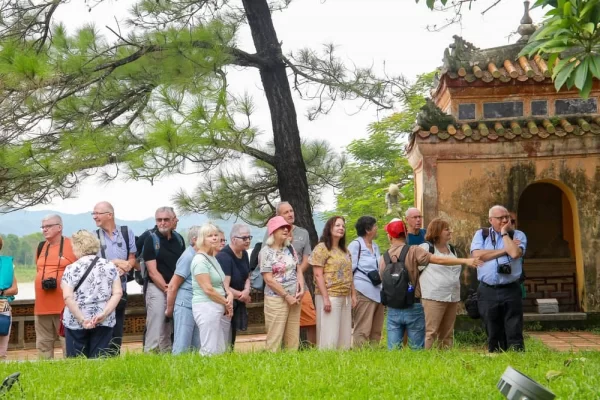
Any visitor to Thien Mu Pagoda feels the peace.
Many visitors choose to visit early in the morning or at sunset when the gentle sunlight stretches across the riverbank, creating a serene and comfortable atmosphere. This is an ideal time to step away from the city’s hustle and bustle, relax the mind, and enjoy the peaceful, meditative natural setting.
2. Learn About Buddhist Life
Thien Mu Pagoda is not only renowned for its architectural beauty but also holds an important place in the Buddhist life of Hue. International visitors have the chance to delve deeper into Buddhism through religious activities and rituals at the pagoda. Each day, monks perform various meditation and prayer rituals, offering visitors a unique opportunity to witness and experience the spiritual essence of Vietnamese Buddhism.
During major Buddhist festivals, such as Buddha’s Birthday or Vu Lan, Thien Mu Pagoda becomes lively with grand ceremonies. These events attract many Buddhists and tourists, not only to participate in religious practices but also to gain a deeper understanding of the spiritual culture and the profound human values that Buddhism offers. Visitors can feel the locals’ deep reverence and respect for their religion, broadening their understanding of spiritual life in Vietnam.
Learn more about: Discover Central Vietnam Tour in 6 Days
3. Photography by Phuoc Duyen Tower
One of the highlights of visiting Thien Mu Pagoda is the chance to take stunning photos with Phuoc Duyen Tower and the poetic Perfume River as a backdrop. The seven-story Phuoc Duyen Tower, built in 1844 during the reign of King Thieu Tri, has become a famous architectural symbol of the pagoda. With its intricate design and prominent location, the tower offers an ideal setting for visitors to capture memorable moments during their visit to Hue.
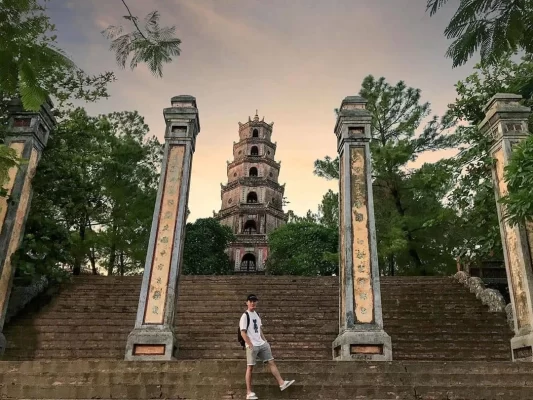
Every tourist wants to record memories at Phuoc Duyen tower.
In front of the Phuoc Duyen Tower are steps leading down to the Perfume River, where visitors can take panoramic photos with the blue sky and calm river as the backdrop. Many choose to take shots from higher points in the pagoda to capture the full view of the tower and the meandering river below, creating a harmonious image that blends ancient architecture with nature.
Do not miss: Best things to do in Hue
VI. Useful Information for Tourists
1. Entrance Fee
Completely Free: Thien Mu Pagoda is open to all visitors, both locals and international tourists, free of charge. There are no entry fees, allowing guests to easily enjoy and explore this historic pagoda without worrying about costs. This is especially convenient for budget-conscious travelers who want to experience the culture and religion at one of Vietnam’s oldest temples.
2. Visitor Etiquette at the Pagoda
- Dress Respectfully: Visitors are advised to wear appropriate clothing, particularly when entering sacred areas like shrines and meditation zones. Proper attire includes wearing long pants and modest tops, avoiding short or sleeveless clothing. This shows respect for the local culture and religious practices.
- Keep Quiet: Thien Mu Pagoda is a sacred place, serving the spiritual and religious needs of many locals. Visitors should avoid speaking loudly and maintain silence to avoid disturbing worshippers who are praying or meditating. The quietness also helps visitors fully experience the serene and solemn atmosphere of the pagoda.
- Do Not Touch Artifacts: The pagoda houses many ancient artifacts, Buddha statues, and religious items. Visitors should refrain from touching these objects and avoid taking photos in prohibited areas, which are usually clearly marked.
- Dispose of Trash Properly: While there are many public spaces to relax and admire the scenery, visitors should keep the environment clean by disposing of trash in designated bins to preserve the sacredness of the pagoda.
3. Opening Hours of Thien Mu Pagoda
Thien Mu Pagoda is open daily from 8:00 AM to 5:00 PM, fitting well with various tourist schedules. This time frame allows visitors to come in the morning to enjoy the cool and peaceful atmosphere or visit in the afternoon to witness the breathtaking sunset from the pagoda, which sits on a hill overlooking the Perfume River. However, during major Buddhist holidays, the pagoda may be more crowded due to locals coming to worship.
4. Best Time to Visit Thien Mu Pagoda
The best time to visit is during the dry season, from February to August, when Hue’s weather is generally pleasant, with little rain and beautiful sunshine. This is an ideal time for walking around the pagoda, enjoying the natural beauty along the Perfume River, and admiring the ancient architecture in natural light.
Avoid the Rainy Season: From September to January, Hue often experiences heavy rains and occasional storms, making outdoor sightseeing more challenging. The path leading up to the pagoda can also become slippery, especially on the trails and steps. However, if visiting during this time, travelers can still experience the quiet and reflective atmosphere of the pagoda in the rain, which offers a somber and ancient charm.
Click here: Hue tours
VII. Nearby Attractions
After visiting Thien Mu Pagoda, you can explore several nearby attractions that highlight Hue’s historical and cultural heritage. Here are a few suggestions to enhance your itinerary:
1. An Dinh Palace
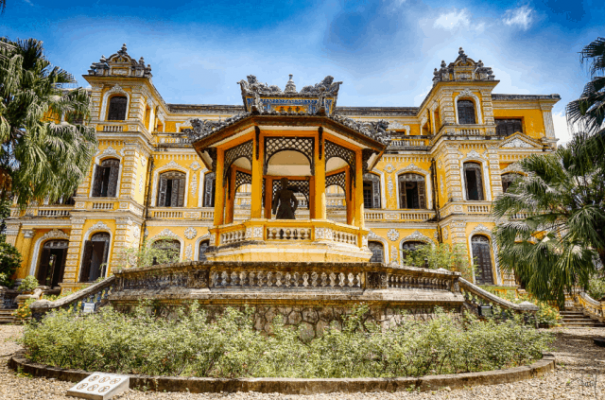
An Dinh Palace was once the residence of many Nguyen Dynasty kings.
Located just a short drive from the pagoda, An Dinh Palace is a lesser-known gem of Hue. This former royal residence showcases a blend of French and Vietnamese architectural styles, offering a glimpse into the lifestyle of the Nguyen Dynasty. The intricate details of the building’s interior and the peaceful surrounding gardens make it a must-see spot for history and architecture enthusiasts.
Read more: Best Day Trip from Hue to Phong Nha for Your Vacation
2. Tu Duc Tomb
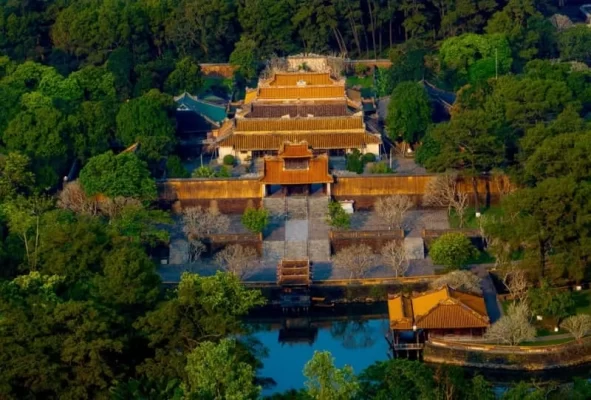
Tu Duc Tomb
One of the most impressive and beautifully preserved imperial tombs in Hue, the Tu Duc Tomb is a peaceful retreat surrounded by lush greenery and tranquil ponds. Built for Emperor Tu Duc, this site is known for its serene atmosphere and intricate stone carvings. The tomb is a perfect complement to your visit to Thien Mu Pagoda, providing further insight into the rich history of the Nguyen Dynasty.
3. Vong Canh Hill
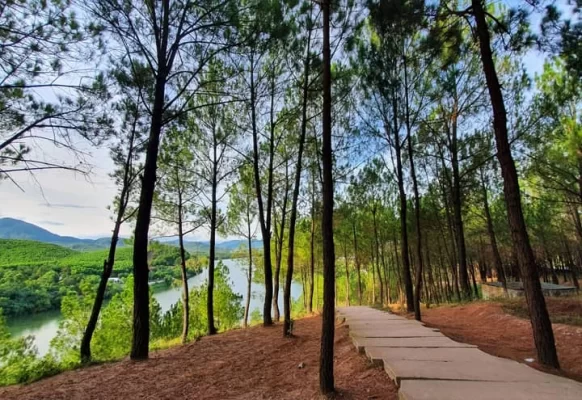
Vong Canh Hill
For nature lovers and those seeking panoramic views, a trip to Vong Canh Hill is highly recommended. Located a short distance from the pagoda, this hill offers stunning views of the Perfume River and the surrounding landscape. It’s an ideal place to relax, enjoy a picnic, or simply take in the beautiful scenery. The quiet atmosphere and natural beauty make it a peaceful stop after exploring Hue’s historical sites.
In conclusion, Thien Mu Pagoda is more than just a historical site; it’s a window into Vietnam’s deep spiritual and cultural legacy. Nestled along the peaceful Perfume River, its striking architecture, particularly the iconic Phuoc Duyen Tower, creates a serene atmosphere perfect for reflection and exploration. For international travelers, the pagoda offers a unique blend of history, spirituality, and natural beauty, making it an unmissable destination in Hue. Visiting Thien Mu Pagoda is not only an opportunity to admire ancient Buddhist architecture but also a chance to experience Vietnam’s enduring cultural and religious heritage firsthand.
See more: Hue travel tips




